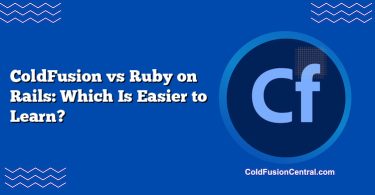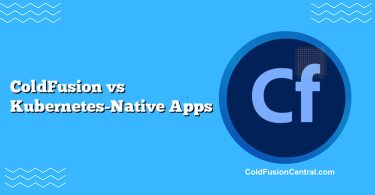Definitions
- ColdFusion (CFML):
ColdFusion is a server-side web development platform centered on CFML (ColdFusion Markup Language). It is available as Adobe ColdFusion (commercial) and Lucee (open-source). CFML runs on the JVM, compiles to bytecode, and offers a tag-based and script syntax aimed at rapid application development (RAD) of dynamic websites, REST APIs, and enterprise intranet apps. - Python for Web Development:
Python is a general-purpose programming language with multiple web frameworks, notably Django (full-stack), Flask (microframework), and FastAPI (modern, async-friendly). Python apps run under WSGI or ASGI servers (e.g., Gunicorn, Uvicorn), and integrate with vast libraries for databases, caching, data science, machine learning, and DevOps workflows.
Overview
Technology Stack and Architecture
- ColdFusion
- Language: CFML (tags and CFScript).
- Runtime: JVM (Java Virtual Machine).
- Deployments: Adobe ColdFusion or Lucee servers.
- Integration: Deep Java interoperability, built-in mail, PDF, image processing, ORM (Hibernate), and scheduler.
- Typical HTTP model: App server handles routing and rendering; often fronted by IIS/Apache/nginx.
- Python Web Stack
- Language: Python 3.x.
- Frameworks: Django, Flask, FastAPI, Pyramid.
- Servers: WSGI (Gunicorn/uwsgi) for sync apps, ASGI (Uvicorn/Hypercorn) for async apps and WebSockets.
- Integration: Rich package ecosystem (PyPI), ORMs (Django ORM, SQLAlchemy), task queues (Celery, RQ), security middleware, cloud-native tooling.
Typical Use Cases
- ColdFusion
- Rapid CRUD apps, forms-heavy business applications, report generation (PDF/Excel), internal portals, scheduled jobs.
- Enterprises with existing CFML codebases, government agencies, and organizations preferring JVM-based deployment with RAD.
- Python
- Content-heavy websites, REST/GraphQL APIs, microservices, real-time features via ASGI, data analytics dashboards.
- Applications that combine web backends with machine learning, data science (NumPy, Pandas), and MLOps.
Key Features
ColdFusion (Adobe CF / Lucee)
- Built-in batteries:
- PDF generation, image manipulation, email, schedulers, caching, REST services, WebSocket support (version-dependent).
- ORM:
- Hibernate-based ORM for database mappings and transactions.
- Simplicity:
- Tag-based CFML and CFScript enable concise server-side scripting; steep productivity for CRUD and integration tasks.
- JVM power:
- Leverage Java libraries, JDBC drivers, JVM tuning, and enterprise-grade tooling.
- Admin console:
- Central server admin for datasources, security settings, caching, mappings, and scheduled tasks.
Python (Django / Flask / FastAPI)
- Framework choice:
- Django: batteries-included, admin, ORM, auth, forms, migrations.
- Flask: minimalist core, choose your own ORM and components.
- FastAPI: Async-first, auto-generated OpenAPI docs, pydantic validation, very fast I/O performance.
- Ecosystem:
- Massive PyPI library catalog, superb data science and ML (scikit-learn, TensorFlow, PyTorch).
- Deployment flexibility:
- WSGI or ASGI, containerization with Docker, orchestration with Kubernetes, serverless options.
- DevOps-friendly:
- Mature CI/CD toolchains, IaC (Terraform, Ansible), testing frameworks (pytest), code quality tooling (black, mypy).
Language and Syntax Highlights
- CFML
- Tag syntax for templating (, ), and CFScript for more “code-like” flows.
- Simple data access and built-in functions reduce boilerplate for common tasks.
- Python
- Indentation-based readability; extensive standard library.
- Async/await for modern concurrency; clear function decorators, type hints, and dataclasses.
Performance
- ColdFusion
- Runs on the JVM with JIT optimizations; performance can be strong for CPU-bound tasks when tuned.
- Built-in features reduce overhead of integrating components, but some older CFML constructs can be slower if not optimized.
- Production considerations: connection pooling, query caching, JVM heap tuning, and template caching can yield low-latency responses.
- Python
- CPython interpreter with GIL; pure CPU-bound code may be slower than JVM or Java alternatives.
- For I/O-bound workloads (e.g., API gateways, async DB/HTTP calls), FastAPI/ASGI with Uvicorn is highly performant.
- Native extensions (C/Cython), PyPy, or leveraging external services (Redis, Postgres) mitigate performance limits.
- Common pattern: keep request handlers thin, offload heavy work to Celery workers.
Practical takeaway: For high-throughput I/O-bound APIs, Python with ASGI often excels. For compute-heavy templates or Java interop, tuned ColdFusion can be competitive. Real performance depends on architecture, caching, and database design more than language alone.
Scalability
- ColdFusion
- Vertical scaling is straightforward; horizontal scaling requires session management strategy (sticky sessions or external session store).
- Clustering options via app server and load balancers; JVM-based, so integrates with enterprise infrastructure.
- Microservices possible, though CF is more commonly used in monolithic or modular monolith patterns.
- Python
- Designed for scale-out via process workers (Gunicorn) and async event loops (ASGI).
- Plays well with containers, Kubernetes, and service meshes; robust for microservices and event-driven architectures.
- Easy to isolate services and use queues (Celery + RabbitMQ/Redis).
Security
- ColdFusion
- Admin console supports IP lockdown, secure profile. Built-in functions for input validation, XSS and CSRF defenses (version-specific).
- ORM helps prevent SQL injection when using parameters. Regular vendor updates (Adobe ColdFusion security hardening guides).
- Attack surface to monitor: outdated CFML tags, deserialization issues, permissive Admin console exposure.
- Python
- Django provides CSRF, XSS, clickjacking protections by default; robust auth and permissions.
- Flask/FastAPI rely on selected extensions and middlewares; security is excellent with proper setup.
- Strong static analysis and testing ecosystem; frequent CVE response across popular packages.
Both stacks benefit from OWASP-aligned practices: parameterized queries, output encoding, strict session handling, and dependency updates.
Cost
- ColdFusion
- Adobe ColdFusion: commercial, per-core or per-CPU licensing; higher licensing costs but enterprise support.
- Lucee: open-source, no license fee; optional paid support via community vendors.
- TCO factors: smaller teams can ship faster due to built-ins; fewer third-party dependencies.
- Python
- Python and frameworks: open-source, zero licensing cost.
- Hosting: abundant low-cost options; cloud-native deployments reduce vendor lock-in.
- TCO factors: talent availability is high, extensive libraries reduce dev time; need to assemble components (mail, PDF, etc.) can add integration effort.
Community Support and Ecosystem
- ColdFusion
- Smaller community; strong niche expertise; active Lucee and Adobe forums; fewer third-party plugins than Python.
- Long enterprise history; stable for legacy and regulated environments.
- Python
- Massive global community, extensive documentation, tutorials, and conferences.
- Ecosystem breadth covers web, data science, ML, DevOps, automation, and scientific computing.
Real-World Scenarios
When ColdFusion Might Be Preferred
- Scenario: Internal HR portal with forms, document generation, and scheduled reports
- Requirements: Complex forms, PDF export, email notifications, LDAP/AD integration, nightly batch jobs.
- Why CF helps:
- Built-in PDF and email features reduce time-to-market.
- Scheduler and admin console simplify batch tasks and monitoring.
- Hibernate ORM handles CRUD with minimal boilerplate.
- Outcome: A small team delivers a robust intranet app quickly, with straightforward JVM deployment behind corporate IIS/nginx.
When Python Might Be Preferred
- Scenario: Public API with high concurrency plus analytics and ML-backed recommendations
- Requirements: Async REST APIs, WebSockets for real-time updates, integration with Pandas/NumPy, and model inference via PyTorch.
- Why Python helps:
- FastAPI + Uvicorn handles tens of thousands of concurrent connections efficiently.
- Seamless use of ML/DL libraries for inference endpoints.
- Microservices split: API, worker queue (Celery), feature store (Redis), model service.
- Outcome: Cloud-native, horizontally scalable services with CI/CD pipelines, canary deploys, and rapid iteration on ML features.
Side-by-Side Comparison Table
| Aspect | ColdFusion (Adobe/Lucee) | Python (Django/Flask/FastAPI) |
|---|---|---|
| Language/Runtime | CFML on JVM | Python 3 on CPython (WSGI/ASGI) |
| Performance | Strong with JVM tuning; great for built-in tasks | Excellent for I/O with ASGI; CPU-bound needs care |
| Scalability | Vertical + cluster; common for monoliths | Cloud-native, microservices-friendly, easy scale-out |
| Security | Admin controls; built-ins; vendor patches | Strong frameworks (Django); many security libraries |
| Cost | Adobe license or free Lucee; fewer deps | Free; low-cost hosting; assemble components |
| Ecosystem | Smaller, enterprise-focused | Huge ecosystem, data science and ML leadership |
| Use Cases | Internal apps, reports, CFML legacy | APIs, content sites, data-driven and ML services |
| Learning Curve | Easy for RAD; CFML-specific | Widely taught; abundant resources |
| Pros | RAD, built-in features, JVM integration | Flexibility, libraries, async, large talent pool |
| Cons | Smaller community; licensing (Adobe) | Fragmentation; need to pick/maintain many components |
Pros and Cons
ColdFusion Pros
- Fast development for CRUD, PDF, email, and scheduled tasks with minimal boilerplate.
- JVM-based: stable, tunable, and interoperable with Java libraries and enterprise tooling.
- Centralized administration and robust ORM integration.
- Lucee offers a free, open-source path with good performance.
ColdFusion Cons
- Smaller community and fewer modern examples compared to Python.
- Adobe licensing cost can be high; upgrades and patches must be planned.
- Some hosting providers are less familiar with CF stacks than with Python/Node.
- Modern async and microservices patterns require more effort.
Python Web Pros
- Broad framework choice: Django (batteries-included), Flask (lightweight), FastAPI (async).
- Massive library ecosystem across web, data, ML, DevOps; easy integration with NumPy, Pandas, ML models.
- Excellent for microservices, ASGI-based concurrency, and cloud-native deployments.
- Large talent pool; rich documentation and community support.
Python Web Cons
- More decisions upfront (framework, ORM, auth, admin, etc.).
- CPU-bound workloads may need native extensions, caching, or offloading.
- Security posture depends on selected libraries and correct configuration (especially beyond Django).
Decision Factors / Which One Should You Choose?
- Choose ColdFusion if:
- You maintain or extend an existing CFML codebase.
- You need RAD for forms, reports, scheduled tasks, and email without wiring many libraries.
- Your organization prefers JVM deployments and centralized admin tools.
- You want an opinionated, integrated platform with minimal assembly.
- Choose Python if:
- You plan to build APIs or microservices and scale horizontally in containers.
- You expect to integrate analytics, machine learning, or data pipelines.
- You want zero licensing costs and access to a large talent pool and ecosystem.
- You need async performance (FastAPI/ASGI) and real-time features.
Practical tip: If you’re starting greenfield, lack CFML expertise, and anticipate data/ML features or microservices, Python is usually the safer bet. If you’re optimizing for swift delivery of business workflows with built-in PDF/email/scheduler and have CFML skills available, ColdFusion can deliver quickly and reliably.
Supported Platforms and Deployment
- ColdFusion (Adobe/Lucee)
- OS: Windows, Linux (various distros).
- Web servers: IIS, Apache, nginx (as reverse proxy).
- Databases: Any JDBC-compatible (SQL Server, Oracle, MySQL/MariaDB, PostgreSQL).
- Packaging: WAR/EAR-style deployment possible; Docker images available from community/vendor.
- Admin: Central console for datasources, security, caching, scheduled tasks.
- Python (Django/Flask/FastAPI)
- OS: Linux, Windows, macOS; most production deploys on Linux.
- Web servers: nginx/Apache as reverse proxy; app servers via WSGI (Gunicorn/uwsgi) or ASGI (Uvicorn/Hypercorn).
- Databases: Postgres, MySQL/MariaDB, SQLite, Oracle; ORM support via Django ORM/SQLAlchemy.
- Packaging: Virtualenv/venv/poetry; Docker and Kubernetes common; serverless options (AWS Lambda, Cloud Run).
- CI/CD: Mature pipelines with GitHub Actions, GitLab CI, Jenkins; infrastructure as code.
Key Takeaways / Summary Points
- ColdFusion and Python both support modern, secure web development; the bigger differences lie in ecosystem breadth, licensing, and architectural patterns.
- ColdFusion shines for rapid application development with built-in PDF, mail, ORM, and scheduling—ideal for business workflows and CFML legacy environments.
- Python offers unmatched flexibility, async performance for I/O-bound APIs, and first-class data science/ML integration.
- Cost, hiring, and long-term maintainability often favor Python; time-to-market with minimal assembly can favor ColdFusion, especially within JVM-centric enterprises.
- Your decision should align with existing skills, deployment preferences, and whether you expect data/ML or microservices at scale.
FAQ
Is ColdFusion still relevant for new projects?
Yes, particularly in organizations that value rapid delivery of forms, reports, and scheduled processes, or where JVM-centric operations and CFML expertise already exist. Lucee provides an open-source path, and Adobe ColdFusion offers enterprise support and tooling.
Which Python framework should I pick for a new web API?
If you need high performance for I/O-bound requests and great developer ergonomics, FastAPI is a strong choice. For a full-featured, batteries-included platform with an admin and ORM, pick Django. Choose Flask when you want a minimal core and complete control over extensions.
How do hosting and deployment differ between ColdFusion and Python?
ColdFusion apps deploy to an Adobe CF or Lucee server, often behind IIS/Apache/nginx; administration is centralized. Python apps typically run under WSGI/ASGI servers (Gunicorn/Uvicorn) behind nginx, and are commonly containerized for Kubernetes or deployed to serverless platforms.
Can I integrate machine learning with ColdFusion?
Yes, via Java libraries on the JVM or REST calls to external ML services. However, Python provides first-class ML tooling (NumPy, Pandas, scikit-learn, PyTorch, TensorFlow) and is the natural choice if ML integration is a core requirement.
What about long-term maintainability and hiring?
Python benefits from a large, active community and talent pool, making hiring and long-term maintenance straightforward. ColdFusion has a smaller but dedicated community; organizations with existing CFML teams can maintain systems effectively, but recruiting may be more challenging.




